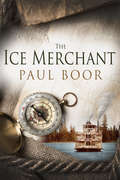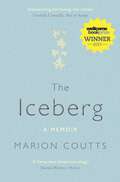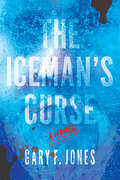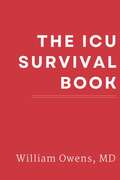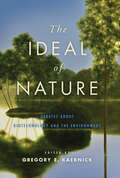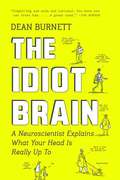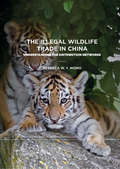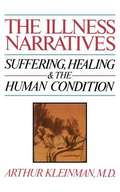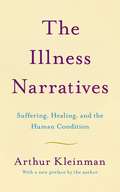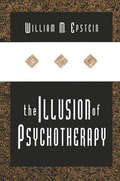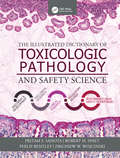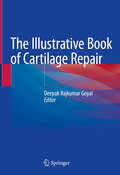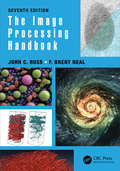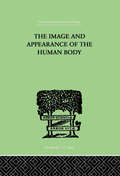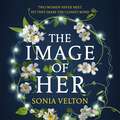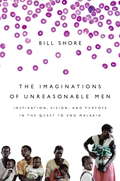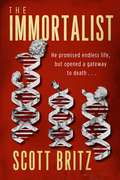- Table View
- List View
The IVF Blueprint: Everything You Need to Know About In Vitro Fertilization, Egg Freezing, and Embryo Transfer
by Susan Hudson Abby Eblen Carrie BedientThe definitive guide to IVF from leading physicians who have helped thousands of patients successfully navigate fertility treatment—and will demystify the process for you. Wherever you are in your fertility journey, you&’re bound to have questions. What should I ask at the first doctor visit? Are there supplements that might give my ovaries that extra kick? Do I have a good chance of getting pregnant? Drs. Abby Eblen, Carrie Bedient, and Susan Hudson get real about what you can really expect from IVF—and simplify the complex world of fertility to give you the best possible chance of success. The IVF Blueprint covers every aspect of the process, from preparing for IVF to egg retrieval, recovery, embryo transfer, and more, including valuable insights on: The science behind IVF and egg freezing Step-by-step explanations of each procedure Strategies to maximize your odds of success Emotional and physical considerations during treatment Combining deep expertise, their personal experiences as IVF patients, and the candid style of their Fertility Docs Uncensored podcast, Drs. Abby, Carrie, and Susan are there with you for every step of the way, sharing everything they know to help you welcome your newest family member.
The Ice Merchant
by Paul BoorIt's the year 1889, and a shrewd Yankee ice merchant, Nicolas Van Horne, has been carving out a profitable side-business. Deep in his ship's icy hold, dozens of human cadavers lie between the huge blocks of ice. On this delivery, his first to Galveston's new Medical School, Nicolas makes the ghastly discovery that he's been trafficking in murdered boys. Only with the help of Renée Keiller, Galveston's lovely lady scientist, will Nicolas eventually solve the puzzle his ice holds . . . but first he must overcome his personal demon of morphine addiction, and become inextricably entangled in Renée's experiments on the most dreaded killer of the time, Yellow Fever.Paul Boor, M.D., is a scientist and professor at Galveston's medical school, the oldest west of the Mississippi. His first novel, BLOOD NOTES, was a modern biomedical thriller. In THE ICE MERCHANT, Dr. Boor explores the history of the body trade, while plumbing the depths of the human frailties of those devoted to scientific discovery.
The Iceberg: A Memoir
by Marion CouttsIn 2008 the art critic Tom Lubbock was diagnosed with a brain tumor. The tumor was located in the area controlling speech and language, and would eventually rob him of the ability to speak. He died early in 2011. Marion Coutts was his wife. In short bursts of beautiful, textured prose, Coutts describes the 18 months leading up to her partner's death. This book is an account of a family unit, man, woman, young child, under assault, and how the three of them fought to keep it intact. Written with extraordinary narrative force and power, The Iceberg is almost shocking in its rawness. It charts the deterioration of Tom's speech even as it records the developing language of his child. Fury, selfishness, grief, indignity, and impotence are all examined and brought to light. Yet out of this comes a rare story about belonging, an "adventure of being and dying." This book is a celebration of each other, friends, family, art, work, love, and language.
The Icelandic Doc's Baby Surprise: The Icelandic Doc's Baby Surprise / Christmas With Her Lost-and-found Lover (Mills And Boon Medical Ser.)
by Louisa HeatonTheir passionate fling…Has given them a gift to last a lifetime!When pediatrician Merry Bell turns up at his hospital in Iceland, Dr. Kristjan Gunnarsson’s quiet Christmas is shaken up. After a hot fling together in Hawaii, they both agreed to walk away. But now Merry has brought him life-changing news—she’s pregnant! Commitmentphobic Kristjan will not waver from his responsibility, but is his bruised heart ready for a family?From Harlequin Medical: Life and love in the world of modern medicine.
The Iceman's Curse
by Gary F. JonesNature, climate, and stupidity produce a pandemic.Grant Farnsworth, a post-doc student, veterinarian, and virologist at the University of Minnesota is upset when his professor tells him to prepare to work on tissue samples from a 1,200-year-old corpse called the Iceman, that was found in the Swiss Alps. Grant is already working seven days a week and his wife is eight months pregnant with their second child. The situation becomes more complicated when a Swiss professor, to avoid regulations, smuggles the samples into the United States, putting Grant and his professor in legal jeopardy.When a blizzard diverts the professor's flight to Chicago, Customs is hectic, and the professor mistakenly swaps his suitcase with Frank, a drug mule. When Frank discovers the mistake he and a friend follow the professor north on I-94 with the intention to do whatever is necessary to recover the missing drugs. When snow forces the professor to stop at a motel in the hamlet of Kirby, Wisconsin, he has no idea that he's carrying drugs and that his life is in jeopardy.When Switzerland announces that those who handled Iceman samples are ill, and several have died, Grant is sent to Kirby to find the Swiss professor and isolate the samples. At the same time, the CDC learns of the samples in Kirby and dispatches Dr. Sybil Erypet to Fort McCoy, a nearby Army base, to get the samples under control.Between dangerous drug mules and infected tissue samples, many lives in the snow-bound village are in jeopardy.
The Icu Survival Book
by William Owens Lorien OwensThe ICU Survival Book is a guide for residents, students, advanced practice providers, and critical care nurses who want to learn the basics of critical care medicine. This reference is designed to follow the systems-based format that is used during rounds in the intensive care unit. Hemodynamics, respiratory failure, neurocritical care, and massive transfusion protocols are among the topics covered. The ICU Survival Book is not a comprehensive textbook on critical care. It is designed to be a tool to be used at the bedside, between patients, and in the workroom. Each section has a list of things you'll be expected to know on rounds, along with the key concepts you must understand to survive your ICU rotation. The ICU Survival Book is the latest publication from the author of the internationally bestselling The Ventilator Book. Dr. William Owens is known for explaining complex medical subjects in terms that are easy for learners to understand. This book is perfect for trainees, students on clinical rotations, and unit staff.
The Idea of Epilepsy: A Medical and Social History of Epilepsy in the Modern Era (1860–2020)
by Simon D. ShorvonEpilepsy has a fascinating history. To the medical historian Oswei Temkin it was 'the paradigm of the suffering of both body and soul in disease'. It is justifiably considered a window on brain function. And yet its story is more than simply a medical narrative, but one influenced also by scientific, societal and personal themes. Written for a medical and non-medical readership, this book describes the major developments in epilepsy between 1860–2020, a turbulent era in which science dominated as an explanatory model, medical theories and practices steered an erratic course, and societal attitudes and approaches to epilepsy fluctuated dramatically. In the middle of this maelstrom was the person with epilepsy at the mercy of social attitudes and legislation, and at times harmed as well as helped by medicine and science. So entangled is the history that intriguingly, as an entity, epilepsy may now be thought not even to exist.
The Ideal of Nature: Debates about Biotechnology and the Environment
by Gregory E. KaebnickGoing back at least to the writings of John Stuart Mill and Jean-Jacques Rousseau, people have argued for and against maintaining a state of nature. Is there an inherent virtue in leaving alone a naturally occurring condition, or does the human species thrive when we find ways to improve our circumstances? This volume probes whether "nature" and "the natural" are capable of guiding moral deliberations in policy making.Drawing on philosophy, religion, and political science, this book examines three questions central to debates over the idea of "nature" in human action. Conceptually, it asks what the term means, how it should be considered, and if it is, even in part, a social construct. From a moral perspective, the contributors question if being "natural" is itself of value or if its worth is only as a means to advance other morally acceptable ends. Politically, essays discuss whether appeals to nature can and should affect public policy and, if so, whether they are moral trump cards or should instead be fitted alongside or weighed against other concerns. Achieving consensus on these questions has proven elusive and seems unattainable. This should not, however, be an obstacle to moving the debate forward. By bringing together disparate approaches to addressing these concepts, The Ideal of Nature suggests the possibility of intermediate positions that move beyond the usual full-throated defense and blanket dismissal found in much of the debate. Scholars of bioethics, environmental philosophy, religious studies, sociology, public policy, and political theory will find much merit in this book’s lively discussion.
The Ideology of Work (International Behavioural And Social Sciences Ser. #Vol. 71)
by P D AnthonyTavistock Press was established as a co-operative venture between the Tavistock Institute and Routledge & Kegan Paul (RKP) in the 1950s to produce a series of major contributions across the social sciences. This volume is part of a 2001 reissue of a selection of those important works which have since gone out of print, or are difficult to locate. Published by Routledge, 112 volumes in total are being brought together under the name The International Behavioural and Social Sciences Library: Classics from the Tavistock Press. Reproduced here in facsimile, this volume was originally published in 1972 and is available individually. The collection is also available in a number of themed mini-sets of between 5 and 13 volumes, or as a complete collection.
The Idiot Brain: A Neuroscientist Explains What Your Head Is Really Up To
by Dean BurnettThe brain may be the seat of consciousness and the engine of all human experience, but it’s also messy, fallible and disorganized. It’s undeniably impressive, but it’s far from perfect, and these imperfections influence everything that humans say, do and experience. In The Idiot Brain, Dean Burnett celebrates the downright laughable things our minds do to us, as well as exposing the fact that people are often way off in their thinking about how the brain works. For example, did you know thatyour memory is egotistical?stress can actually increase your performance at a task?conspiracy theories and superstitions stem from your brain’s insistence that the world isn’t random?the brain’s limitations mean you really can miss something that’s right under your nose?the way the brain’s processing works means that time really does fly if you’re having fun?alcohol can sometimes improve your memory?Dean Burnett’s unpredictable and entertaining first book explores the unexpected side of everyday life, highlighting where conventional thinking is wrong and how our brains trip us up at every turn. This is lucid, funny and smart: in short, the best kind of popular science.
The Ileoanal Pouch: A Practical Guide for Surgery, Management and Troubleshooting
by Janindra Warusavitarne Zarah Perry-WoodfordThis book gives a comprehensive overview of surgery that results in creating an ileoanal pouch or continent ileostomy. It deals with the entire journey of pouch surgery starting from patient selection and counselling to technical tips and tricks and ending in managing pouch function and failure. Containing a patient experience section this volume helps clinicians better understand what a patient expects from the ileoanal pouch.This is a very specialised topic but one that is covered very poorly and this book has the potential to consolidate all that is known about the topic to provide a comprehensive overview on the surgery and its consequences.
The Illegal Wildlife Trade in China: Understanding The Distribution Networks (Palgrave Studies in Green Criminology)
by Rebecca W. WongThis book offers a theoretically-based study on crimes against protected wildlife in mainland China with first-hand empirical data collected over five years. It provides an overall examination of crimes against protected and endangered wildlife and an extensive account of the situation in China, where a significant portion of the illegal wildlife trade is currently happening. This emerging field has become an important topic for enforcement and governments alike yet remains an under-researched area. The collected data covers illegal tiger-parts trade, the illegal ivory trade, and the consumption of protected wildlife. The book will serve as a useful reference for scholars, law-enforcement agencies, lawyers, and conservation and wildlife-protection NGO groups to facilitate their understanding of the growing illegal trade in protected and endangered wildlife. The Illegal Wildlife Trade in China has three general aims: first, to contribute to the general development of green criminology and specifically to the literature of the illegal transactions of protected wildlife at the distribution stage. Second, it aims to understand how illegal transactions are carried out to create insights for policy makers and law enforcement professionals. Finally, Wong seeks to apply theoretical frameworks (such as that of trust, networks, and situational crime prevention) to the understanding of the distribution of illegal wildlife products in order to make contributions to ongoing sociological and criminological discussions.
The Illness Narratives: Suffering, Healing, And The Human Condition
by Arthur KleinmanA Harvard psychiatrist and anthropologist argues that interpreting the illness experience is an art tragically neglected by modern medical training, and presents a compelling case for bridging the gap between patient and doctor. Based on twenty years of clinical experience studying and treating chronic illness, a Harvard psychiatrist and anthropologist argues that diagnosing illness is an art tragically neglected by modern medical training, and presents a compelling case for bridging the gap between patient and doctor.
The Illness Narratives: Suffering, Healing, And The Human Condition
by Arthur KleinmanFrom one of America's most celebrated psychiatrists, the book that has taught generations of healers why healing the sick is about more than just diagnosing their illness.Modern medicine treats sick patients like broken machines -- figure out what is physically wrong, fix it, and send the patient on their way. But humans are not machines. When we are ill, we experience our illness: we become scared, distressed, tired, weary. Our illnesses are not just biological conditions, but human ones. It was Arthur Kleinman, a Harvard psychiatrist and anthropologist, who saw this truth when most of his fellow doctors did not. Based on decades of clinical experience studying and treating chronic illness, The Illness Narratives makes a case for interpreting the illness experience of patients as a core feature of doctoring.Before Being Mortal, there was The Illness Narratives. It remains today a prescient and passionate case for bridging the gap between patient and practitioner.
The Illusion of Psychotherapy
by William EpsteinIn The Illusion of Psychotherapy William Epstein asserts that psychotherapy is probably ineffective and possibly harmful. He maintains that there is no credible clinical evidence that psychotherapy is effective in handling personal or social problems, or that it is more effective than other modes of treatment. The theories that underpin clinical practice remain speculative and their influence over social policy are more ideological than scientific. A skeptical public and its government would be better served, Epstein says, by credible evidence of outcomes. His analysis focuses on whether psychotherapy is effective against a variety of unwanted behaviors, such as drug addiction and depression.The nation's social problems are due to the inadequacies of its core social institutions: families, communities, education, and jobs. Social problems emerge because many people are brought up in deficient families, live in dangerous communities, lack education and jobs, and have few or no routes out of poverty. Poor people are exposed to unrelenting risks to their physical and mental health. It is possible to remedy most deficiencies through human services that compensate for these failed social institutions.This position is inevitably unpopular in psychotherapeutic circles and in light of current political preferences since it requires massive new resources and extensive redistribution of existing resources. The extent of society's problems reflects the degree to which deficits in basic social institutions have been tolerated. Basic services have been lacking while psychotherapy diverts our impulse to address poverty into ineffective strategies. In a challenging conclusion, Epstein urges society to solve its problems by confronting the reality implied by the failure of psy-chotherapy's minhnal interventions: to acknowledge that more is necessary to resolve social need. This leads to general theoretical concerns about theory as such. The Illusion of Psychotherapy will be compelling reading for psychologists, psychotherapists, social scientists, and policymakers.
The Illustrated Dictionary of Toxicologic Pathology and Safety Science
by Pritam S. Sahota, Robert H. Spaet, Philip Bentley and Zbigniew W. WojcinskiThere has been a growing interest in toxicologic pathology, especially as related to its impact on the safety assessment of pharmaceuticals and chemicals, and in drug development. Thus, there is a growing need for an Illustrated Dictionary of Toxicology Pathology and Safety Science (IDTP) that this dictionary aims to fill. The language of toxicologic pathology may be less familiar to a broad range of safety scientists, especially those involved in the safety evaluation of pharmaceuticals and chemicals. The IDTP format provides the brevity and clarity that the user is not likely to receive in a textbook, even if adequately indexed. With the inclusion of descriptions for terms used in toxicology, drug metabolism/pharmacokinetics, and regulatory science, the scope of the IDTP is considerably broadened and decidedly unique in its appeal to all safety scientists. With over 800 photos and illustrations to provide visual context,* an important aim of the IDTP is to present pathological changes as reference examples for terminology, nomenclature, and term descriptions for the entry entry-level as well as seasoned toxicologic pathologist. It will also aid students and non-pathology specialists such as study directors, senior toxicology report reviewers, scientific management of contract research organizations, regulatory agencies, and drug development companies to better understand the biological significance of tissue changes. The IDTP provides a single reference volume for these users to further their understanding and appreciation of biologically significant pathology findings. The IDTP consists of four major areas: 1. A-Z Dictionary of Pathology encompassing all organ systems, together with relevant non-pathology terms supported by references in "For Further Reading" sections. 2. Appendix 1: An Overviews of Drug Development, Nonclinical Safety & Toxicologic Pathology, and Important/Special Topics. 3. Appendix 2: Diagnostic Criteria of for Proliferative Proliferative Lesions in Rodents (Rat and Mouse) and Selected Non-Rodent Laboratory Species containing illustrations with detailed references and links to source material. 4) Appendix 3: Mini-Atlas of Organ System Anatomy and Histology to help re-acquaint the non-pathologist safety scientist with many normal anatomical structures. The editors and contributing scientists (board-certified veterinary pathologists, board-certified toxicologists, allied health safety scientists, health regulatory representatives) have experience from bench-level pathology and toxicology to managing global preclinical safety units in leading pharmaceutical companies. They have considerable experience mentoring pharmaceutical industry project team members, interacting with industry clinicians and representatives of decision-making bodies within the industry, as well as with global health authorities, such as the FDA and EMA. These activities convinced them of the necessity for and usefulness of the IDTP. As experts in their field, they have undertaken the hard work of writing and compiling the information, making the IDTP an exceptional, go-to reference. *Illustrations Editor: Gregory Argentieri
The Illustrated Guide to Assistive Technology and Devices: Tools and Gadgets for Living Independently
by Suzanne Robitaille"A Doody's Core Title 2012"This new illustrated guide to assistive technologies and devices chronicles the use of AT/AD - technology used by individuals with disabilities to perform functions that might otherwise be difficult or impossible. This book empowers people to use assistive technologies to overcome some of their physical or mental limitations and have a more equal playing field. It includes real-life examples about how people with disabilities are using assistive technology (AT) to assist them in daily tasks, and discusses emotional issues related to AT/AD.
The Illustrated MRCP PACES Primer
by Sebastian ZekiThe MRCP PACES examination is a rigorous assessment of the ability to diagnose and treat a wide variety of conditions. Candidates must have the capacity to recall knowledge immediately - identifying possibilities, narrowing their findings and making a correct analysis. This book offers an innovative approach to revision for candidates. It clearly presents a wide variety of conditions in pictorial format, prompting recall with both visual and verbal mnemonics. Each colour page offers a different condition and outlines only the details essential to diagnosis and treatment; a concise, refreshing approach to tackling the vast number of topics required.
The Illustrative Book of Cartilage Repair
by Deepak Rajkumar GoyalThis book employs a wealth of high-quality illustrations to provide the reader with a detailed understanding of the anatomy and the histology of the cartilage, the etiology and the classification of the cartilage lesions, and the numerous techniques employed for cartilage repair. Detailed attention is devoted to healthy cartilage, to each stage in the degenerative process, and to the response of the cartilage to the treatment. Imaging of the damaged and the repaired cartilage, as well as the information on the biomechanics are provided in great detail. The chapters on the techniques cover a wide range of approaches: marrow stimulation techniques, osteochondral cylinder transfer techniques, first, second and third generation autologous chondrocyte implantation techniques, allografts, cell-based therapies, orthobiologic approaches, and the role of 3D printing. The chapters closes with a consideration of the success of rehabilitation devices and the long-term results of cartilage repair.The book will be invaluable for all general orthopaedic and arthroscopic surgeons seeking a deeper knowledge of cartilage science and will help to dispel the confusion that still surrounds the reparative treatment. The authors are recognized experts in the fields of cartilage histology, assessment, classification, and repair.
The Image Processing Handbook
by John C. Russ F. Brent NealConsistently rated as the best overall introduction to computer-based image processing, The Image Processing Handbook covers two-dimensional (2D) and three-dimensional (3D) imaging techniques, image printing and storage methods, image processing algorithms, image and feature measurement, quantitative image measurement analysis, and more.Incorporating image processing and analysis examples at all scales, from nano- to astro-, this Seventh Edition: Features a greater range of computationally intensive algorithms than previous versions Provides better organization, more quantitative results, and new material on recent developments Includes completely rewritten chapters on 3D imaging and a thoroughly revamped chapter on statistical analysis Contains more than 1700 references to theory, methods, and applications in a wide variety of disciplines Presents 500+ entirely new figures and images, with more than two-thirds appearing in color The Image Processing Handbook, Seventh Edition delivers an accessible and up-to-date treatment of image processing, offering broad coverage and comparison of algorithms, approaches, and outcomes.
The Image and Appearance of the Human Body (International Library Of Psychology Ser. #Vol. 163)
by Paul SchilderFirst Published in 1999. Routledge is an imprint of Taylor & Francis, an informa company.
The Image of Her: The perfect bookclub read to get you all talking
by Sonia VeltonStella and Connie have never met and never will. So why is Stella stalking Connie's every move on social media?Stella lives with her mother, a smothering narcissist. Her world has shrunk since the terrible accident that left her a shut-in. Her days are broken up by deliveries from a courier that she always returns and by the irresistible urge to watch the life of a stranger - beautiful Connie - unfold on social media. But why is she so drawn to a woman she has never met? And what caused the accident she doesn't want to speak about? Connie is an expat living in Dubai with her partner, Mark, and their two children. On the face of it she wants for nothing and yet she fears that her husband is turning into a stranger. When she finds herself drawn into the lives of the local domestic helpers, she discovers that there are dark secrets in this glittering city. Two women with nothing in common except a twist of fate. What happens when their lives collide?
The Imaginations of Unreasonable Men: Inspiration, Vision, and Purpose in the Quest to End Malaria
by Bill ShoreA small cadre of scientists-collaborators and competitors-are determined to develop a vaccine for malaria-a feat most tropical disease experts have long considered impossible. Skepticism, doubt, and a host of logistical and financial obstacles dog their quest. Success may ultimately elude them. Why, and how, do they persist? Bill Shore is a writer, philanthropist, and business leader who knows from personal experience the rare and elusive nature of transformative innovation. In this moving and inspiring book, the story of these uncompromising scientists serves as springboard for his passionate inquiry into the character and moral fabric of those who devote their lives to solving the world’s most pressing and perplexing problems. What does it take to achieve the impossible? It takes whatever it takes.
The Immortalist: A Sci-Fi Thriller
by Scott BritzFor fans of Robin Cook and Michael Crichton comes a medical thriller that melds cutting-edge science with ripped-from-the-headlines terror. What happens when a new immortality drug leads to an explosive outbreak of a deadly virus that, if not contained, could wipe out humanity once and for all?World-renowned virologist Dr. Cricket Rensselaer-Wright abruptly abandoned her research in Africa after watching her colleague die tragically from the Ebola virus. When she returns to the States to reunite with her teenage daughter Emmy, her plans are sidetracked. No sooner does she set foot on the campus of Acadia Springs--the research institute where she grew up and Emmy now lives--than her onetime mentor Charles Gifford announces his discovery of the Methuselah Vector, a gene therapy agent that can confer immortality on a patient after a single injection. Gifford's air of triumph is marred when a young woman on campus dies suddenly from a horrific viral infection, eerily similar to the Ebola that drove Cricket out of Africa. Despite Cricket's pleas to slow down the rollout of the Vector and run more tests, Gifford refuses. And when the unthinkable happens--when Emmy falls ill with the same mysterious disease--Cricket is forced to take matters into her own hands. But is it already too late? Gifford will stop at nothing to release the Vector into the world. Mobs are clamoring for it. Cricket has only a few hours to find a cure for Emmy, and to convince the public that Gifford's quest for eternal life may cost the very lives he hopes to save. **The publisher has provided this ebook to you without Digital Rights Management software (DRM) applied so that you can enjoy reading it on your personal devices.**
The Immortality Factor
by Ben BovaProvocative, gripping, startling: bestselling author Ben Bova delivers a knockout read with his trademark blend of cutting edge science and unrelenting suspense….Some see stem-cell research as mankind's greatest scientific breakthrough. Others see a blasphemous attempt to play God. Suddenly, the possibility of immortality exists. Two brothers, both doctors, stand on opposite sides of the controversy. To Dr. Arthur Marshak, his work is a momentous gift to humanity. To Dr. Jessie Marshak, it is a curse. Between them stands a beautiful, remarkable woman both brothers will do anything to save.Somehow, before it's too late, Arthur and Jessie Marshak must bridge the gap that divides them…on an issue that could mean nothing less than life or death for millions.At the Publisher's request, this title is being sold without Digital Rights Management Software (DRM) applied.

